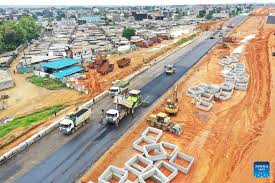In northern Cote d’Ivoire, a new two-lane highway hums with trucks while women balance baskets of mangoes and bananas, calling out to passing drivers along the roadside.
Built by China Harbour Engineering Company Ltd. (CHEC), the 228-km road links Cote d’Ivoire with Mali and Guinea, cutting through the Kabadougou and Folon regions of Denguele District in a Y-shaped route reaching both neighbors. Since opening to traffic in March, it has resolved the long-standing problem of seasonal road blockages during the rainy season.
“This road is a crucial gateway for Mali and Guinea to access Cote d’Ivoire’s seaports,” said Li Yangchun, project manager of the CHEC. “The journey from Odienne, the district capital, to the Malian border has been cut from 4.5 hours to 1.5, and from three hours to one to reach the Guinean border. Transport efficiency has improved dramatically.”
The boost in efficiency has directly benefited the local economy. Denguele District is one of the major production areas of cashews, cotton, and mangoes, but poor road access once hindered exports. That bottleneck is now a thing of the past.
“Before 2020, it was extremely difficult for trucks to come here,” recalled 48-year-old trader Yacouba Kone, who deals in cashews and cement.
From his warehouse, he described how he had witnessed the changes firsthand over two decades in business. “Now trucks come and go freely, and logistics are smooth. Just yesterday, I offloaded two truckloads without a hitch,” he said.
For local farmers, the road carries even deeper meaning. “There used to be no proper roads, and the hilly terrain meant villagers could not bring their produce to town. Many cashews rotted in the fields,” said Aka Kanga, a lab technician on the project who grew up in a nearby village. “This road, built by a Chinese company, is truly a life-changing project for our people.”
“Life is much easier now. With more customers coming and goods moving smoothly, my business is thriving,” said shopkeeper Adiarra Coulibaly, who runs a grocery store along the highway. Pointing at the traffic outside her door, she said her customers now come from across the region.
The road is also opening up a golden corridor across West Africa. Cross-border trader Arouna Diarrassouba, 36, has seen his business flourish since the road opened.
“I trade in clothing, maize and shoes, mostly traveling to Manankoro on the Malian border, sometimes even to Guinea,” he said. “Now the journey is easier, transport is convenient, and my business is better. I travel two or three times a week to do trade.”
The project’s success is also rooted in close integration with local communities. The CHEC prioritized local employment, creating more than 2,000 jobs during construction. It also invested in skills transfer, training engineers and technicians, according to project commercial manager Tian Lei.
“We always try to give back wherever the road reaches: digging wells, repairing village paths, donating school supplies,” said project interpreter Shi Tianhu, who oversees local labor management. “It makes us proud to improve people’s lives in a tangible way.”
“This is an outstanding project that benefits both the country and the people,” said Niamien Assassy Caunan, chief officer of the sub-prefecture of Tienko in Folon Region. “It has truly connected our regions, boosted economic activity, and greatly improved living standards. Traffic has surged, trade is flourishing, new homes are being built, the changes are real and visible.”
XINHUA










